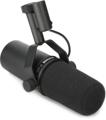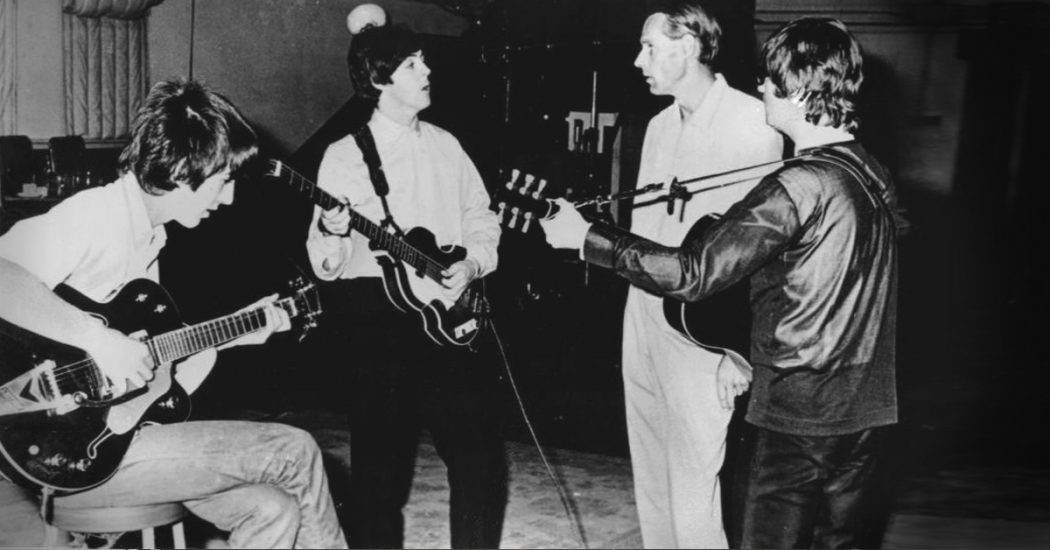
There are a lot of fantastic mics out there. As a matter of fact, Sweetwater carries more than 90 different microphone brands. With that many choices, knowing which mic is best for you can be intimidating. Fortunately, music’s greatest producers and studio engineers have faced the same challenge. Through trial and error, they each discovered their go-to mic — the one they relied on from one session to the next. Let’s take a look at a few of the “mics of the masters” — maybe we can make your decision just a little easier.
Quincy Jones & Bruce Swedien: Shure SM7
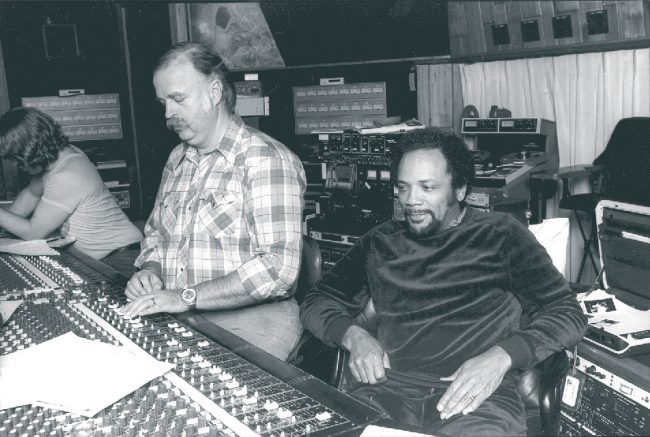
When a 29-time Grammy winner agrees to use a certain mic, you had better listen. That’s why we’re kicking this thing off with Quincy Jones and the Shure SM7.
In 1979, Quincy and his favorite studio engineer Bruce Swedien teamed up to produce Michael Jackson’s Off the Wall. The album went on to sell 20 million copies worldwide. From those heights, the next release had nowhere to go but down. As if that weren’t enough, Michael chimed in with his own expectations for a new album. He was inspired by Tchaikovsky’s The Nutcracker Suite, because “every song was a killer.” He dreamed of making “the biggest-selling album ever.” Quincy set to work on Thriller.
Quincy took a hands-off approach to production. As he would say it, he liked to “leave space for God to walk through the room.” He turned the job of gear selection over to Bruce. “I was allowed the freedom to make microphone choices, and nobody ever said a word. I just did it,” Bruce remembers. In spite of a virtually bottomless budget, Bruce chose to use the humble Shure SM7 to record vocals. He said his choice “raised a lot of eyebrows” because at the time, the SM7 was typically used for daily radio and voice-over work.
What made Bruce choose the SM7? “One of my absolute favorite microphones is the Shure SM7,” he exclaimed. “The first one that I bought was in 1977 — one of the first SM7s to be used on a major music project. It’s dynamic of course and it worked just flawlessly with Michael — if you notice you can hear all the lyrics very clearly.”
Bruce paired his SM7 with a Neve 1084 pre-EQ and a Urei 1176 compressor and began recording. Almost every vocal track, including Vincent Price’s spooky monologue in the album’s monster title track, “Thriller,” was recorded on the SM7.
So do you really need an exotic, budget-crushing mic to get spectacular results? Apparently the answer is no. Thriller sold more than 65 million copies worldwide, making Off the Wall look like cut-out bin fodder, and is indeed the biggest-selling album ever.
https://youtube.com/watch?v=hGdxaehljZM
We know you were expecting Thriller here, but it’s too long, and besides, Eddie’s in this one.
Dr. Dre: Sony C-800G
Dr. Dre has produced albums for some of hip-hop’s largest names, including Snoop Dogg, Eminem, and 50 Cent — winning six Grammys along the way. In other words, the guy knows a thing or two about hip-hop and recording. His favorite mic? The Sony C-800G.
“I like my vocals to sound ‘crystal,'” states Dre. “I use the Sony C-800G for vocals because it has a clean sound and about 85% of the people that get behind it sound great. My main objective is that the vocal sound is present and clean and ultimately does not distort.”
Dre doesn’t need to add much to the Sony C-800G to get the sound he’s looking for. Vito, one of Dre’s main sound engineers, explains it this way: “We come from the Sony C-800G and out of that into the Neve 1073 mic pre,” he says. “We don’t use the EQ, because most of the time it sounds good flat.” They also cycle the sound through an Avalon 737-SP compressor, but they bypass the mic pre. Instead, they go straight into the line input. This allows Dre and Vito to use the compressor by itself whenever it’s needed.
So what does that sound like? Well, it took us a while to find a track “PG-13” enough for inSync, but we did find one. Take a listen to 50 Cent’s breakthrough single, “In Da Club.”
George Martin: Telefunken U48
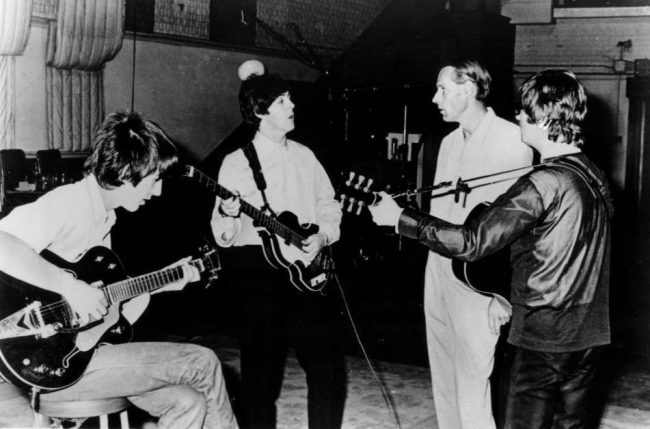
“Hello, I’m the fifth Beatle.” It’s a line no one could successfully use at parties — except for George Martin. As producer for almost all the Beatles’ albums, George had a major influence on the direction of the band. Sure Paul, George (Harrison), Ringo, and John had final say, but George’s suggestions often became their ideas.
From “Please Please Me” to “Let It Be,” the Telefunken U48 was George’s weapon of choice. He was sold on the U48’s strong midrange and rich low-end capabilities, especially when recording vocals and acoustic instruments.
For early Beatles recordings, U48s were used to mic the guitar amps. Often, George would place a single U48 between Paul and John to achieve a perfect balance between the two iconic voices.
The Telefunken U48 helped George Martin and the other four Beatles turn moments like this:
Into moments like this:
https://youtube.com/watch?v=TUTLHYq8XM8
While the U48 played a major role in creating one of the most iconic bands of all time, it is regularly upstaged by its omnidirectional twin, the U47. Which mic is right for you? It comes down to personal preference. Both mics feature cardioid settings, but the U47 can also be omnidirectional, while the U48 switches to the figure-8 setting.
Although original U48 and U47 mics are 5-figure collector-bait, contemporary versions of these mics are offered by Telefunken and Neumann. Which company made the original U48 and U47? That’s a story for a future inSync article.
Alan Parsons: Mix & Match
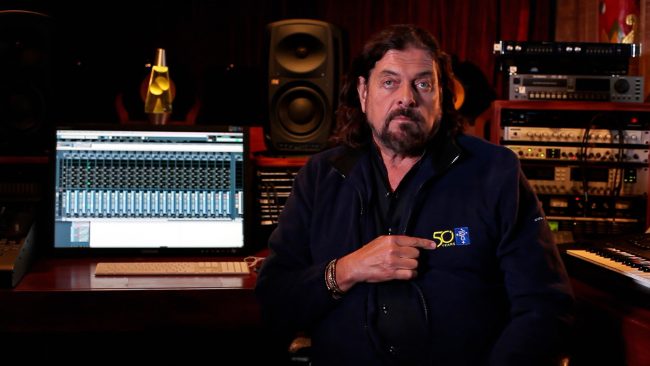
The screenshot of the famous producer Alan Parsons is from a compilation of personal congratulation video messages recorded by a whole host of musicians and notable names in the music industry, many of whom have visited Paranal and have a personal interest in ESO’s work. The messages were recorded at the occasion of ESO’s 50th anniversary celebrations.
Alan Parsons has been a musician, engineer, and producer for more than 50 years. He has worked with some of music’s biggest names, including the Beatles, Pink Floyd, the Hollies, and Al Stewart. Alan has written the book on recording — literally.
When it comes to choosing a favorite mic, Alan has developed a short roster of job-specific mics to get the job done. “I’ve always favoured the Neumann U47,” Alan begins. “I don’t own one, but whenever there’s one available I always try and use it for vocals.” Alan goes on to explain his thoughts on rhythm: “AKG Dynamics on toms-toms,” he says. “I normally favour a condenser mic for snare drums like a Neumann 184, which is unusual because most engineers prefer dynamics on snare drums. I only mic the top of the snare never the bottom.” As you are about to hear, Alan’s combination approach produces chart-topping results.
Rick Rubin: Shure SM57
Johnny Cash. Tom Petty. Danzig. Red Hot Chili Peppers. Eminem. Run-DMC. One of the best ways to describe producer Rick Rubin’s career is “versatility.” Jumping effortlessly from genre to genre, Rick has been nominated for a Grammy 14 times — he’s brought the hardware home eight times.
While it’s difficult to pin Rick down on a single mic, when he finds something that works, he is eager to share it. In Michael Molenda’s book, Making the Ultimate Demo, Rick talked about recording Chad Smith’s drums for the Red Hot Chili Peppers’ song “Give It Away”:
“Chad Smith’s drums were placed in this great solarium which had marble floors and huge glass panes for the walls and ceiling,” Rick explained. “I used only four mics on the kit: a Shure SM57 on the kick drum, an SM57 on the snare, and two AKG C414s for overheads. Individually, the tracks really didn’t sound very good. The kick and snare were thin, and the overheads were pretty washy. But the combination of all the mics sounded amazing. This arrangement was used pretty much throughout the album.”
Rick also talks fondly of the Shure SM57 he and his crew called the “magic mic.” He swore that everything he recorded through it came out sounding great. “I’d say 75% of the overdubs were tracked with that single microphone,” Rick remembers. “It’s kind of funny — the main mic used on this huge multi-platinum record cost about $140.”
So which mic is right for you? If anything, this little exercise has shown that having so many good mics to choose from means that it is hard to get it wrong. The only real limits are your imagination. So go ahead, pick a mic and get to work — there are more masters to be made.



